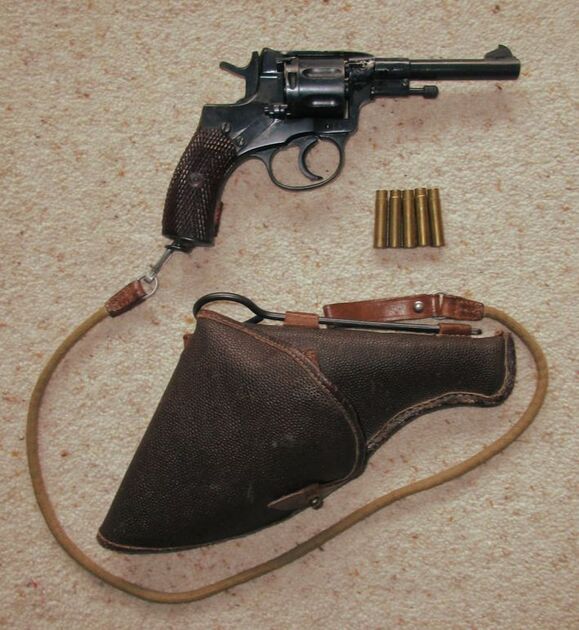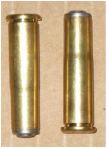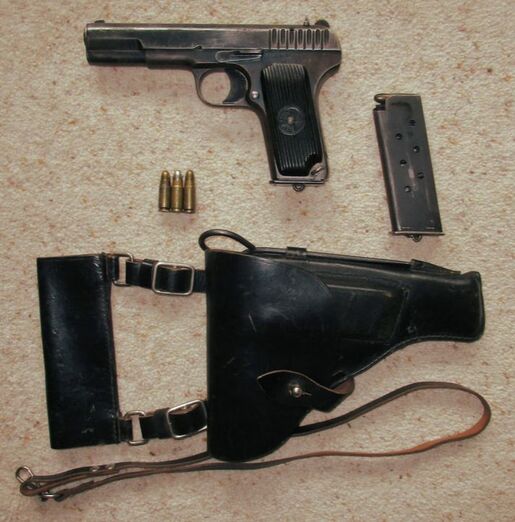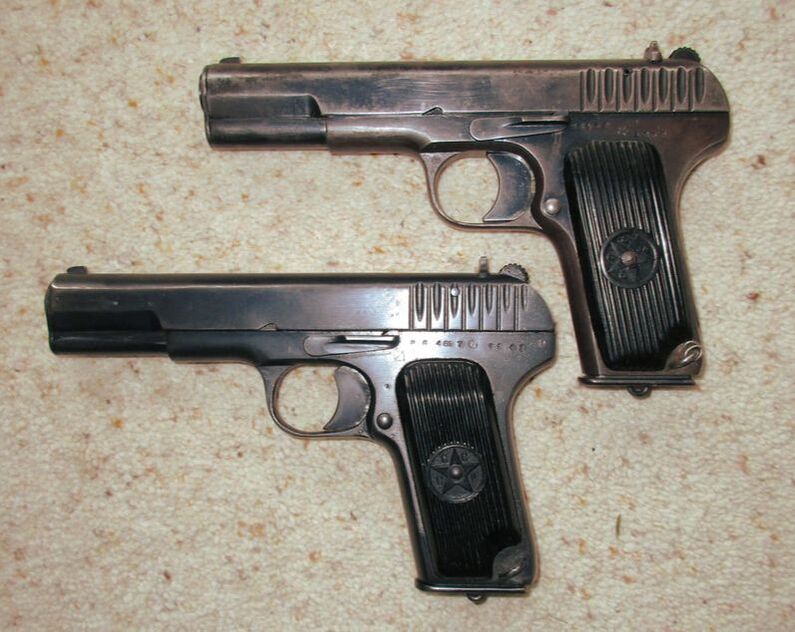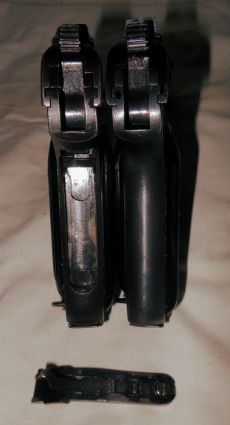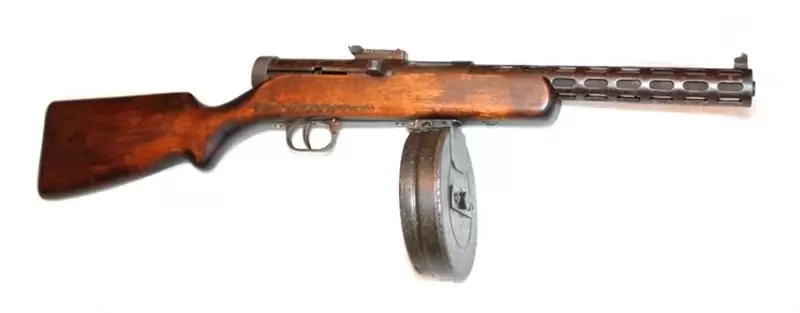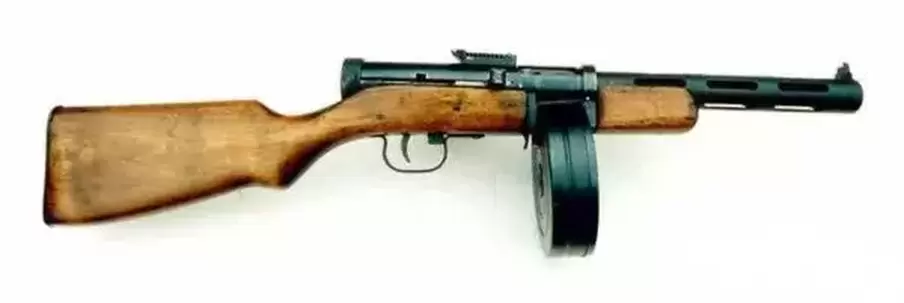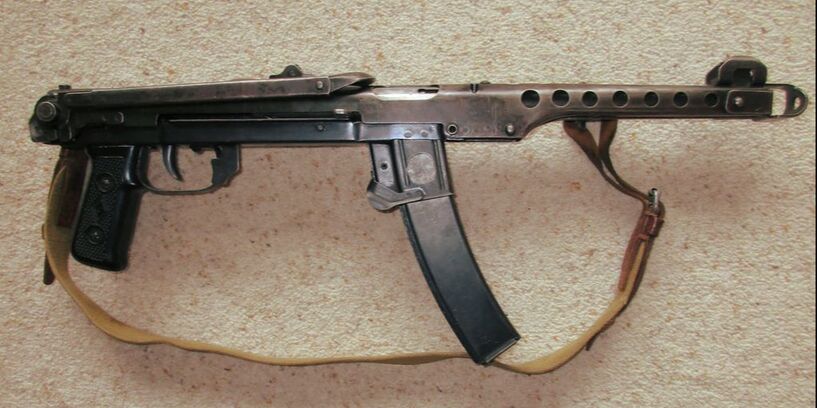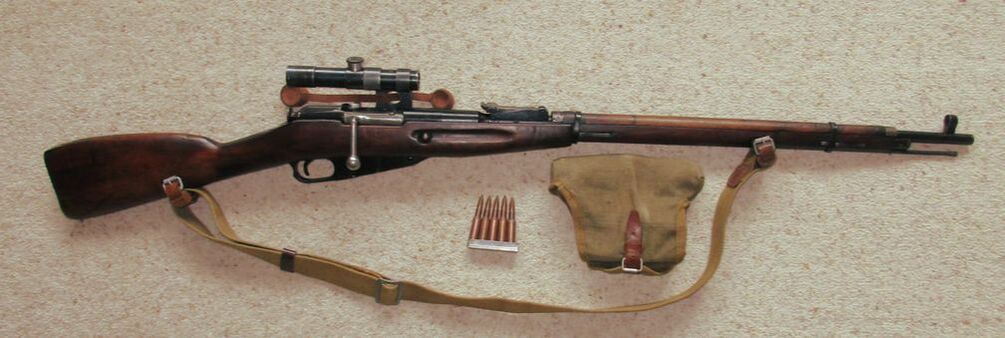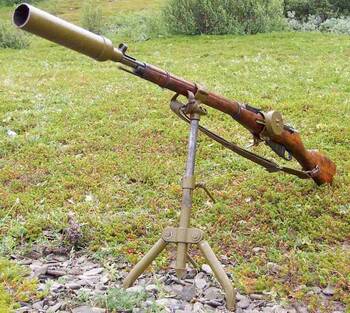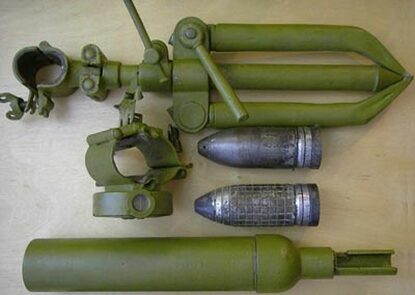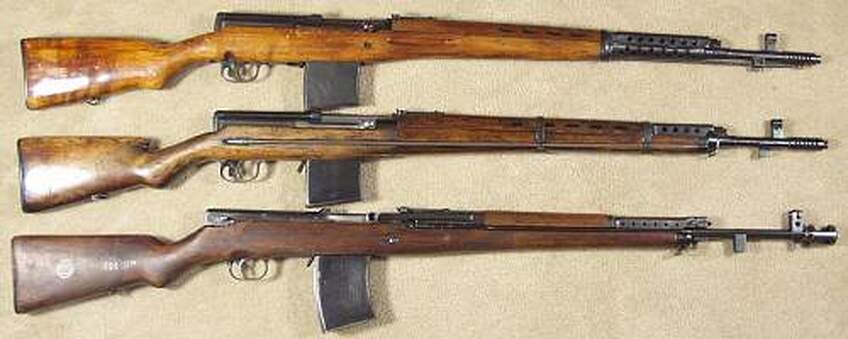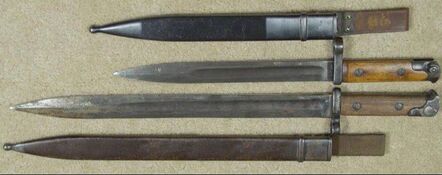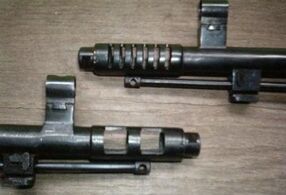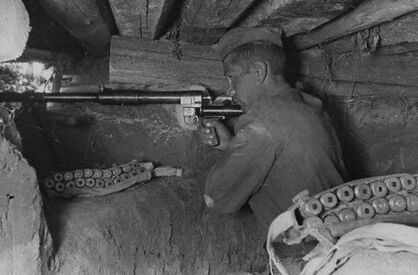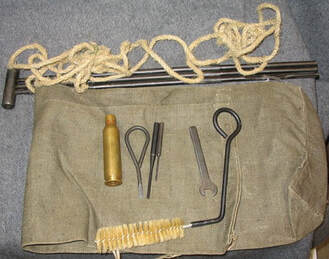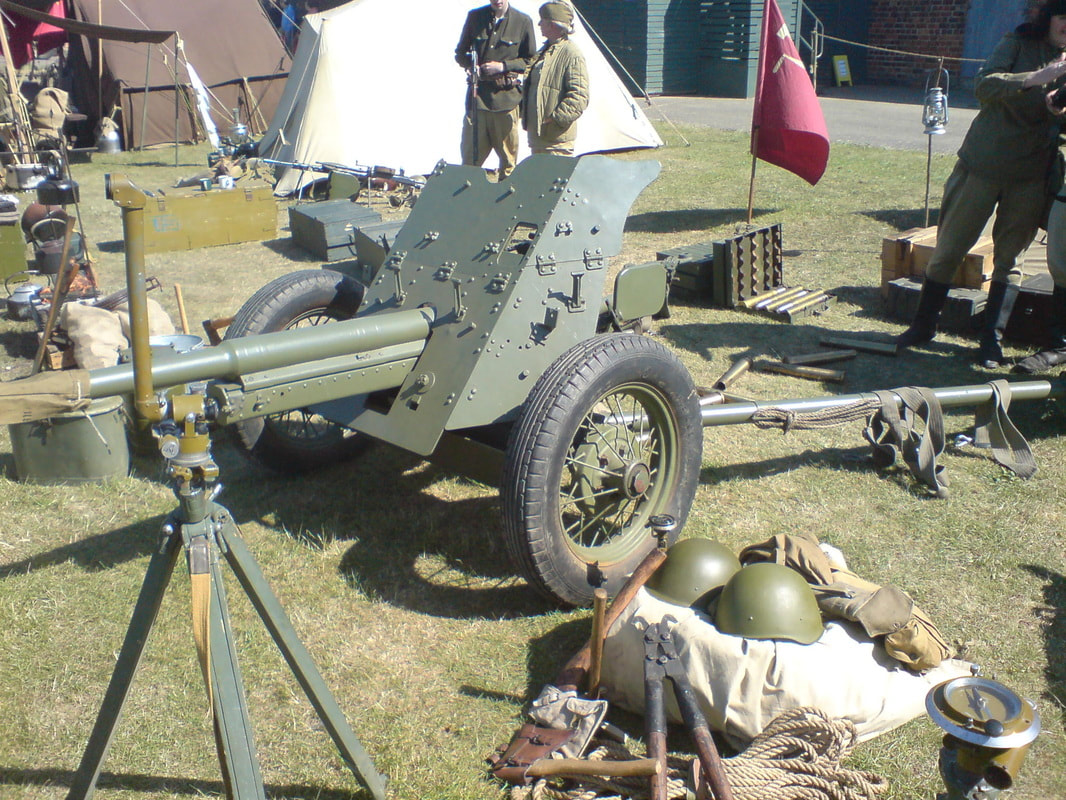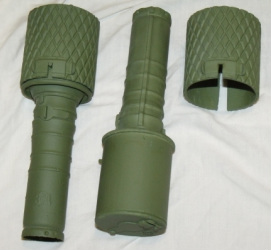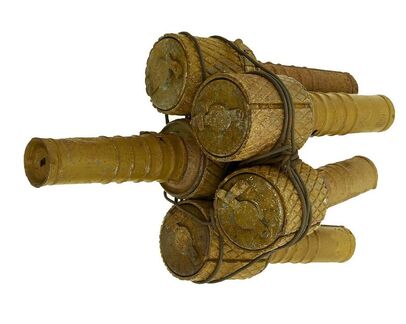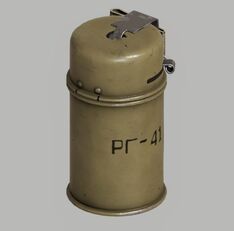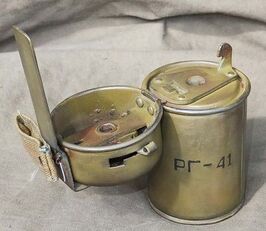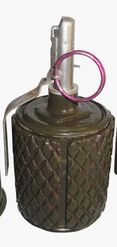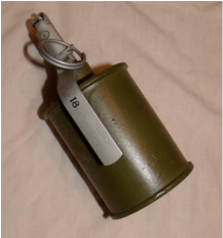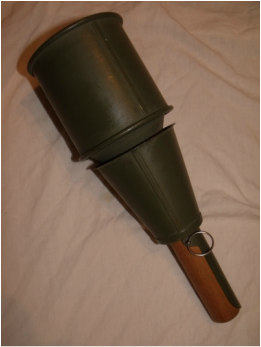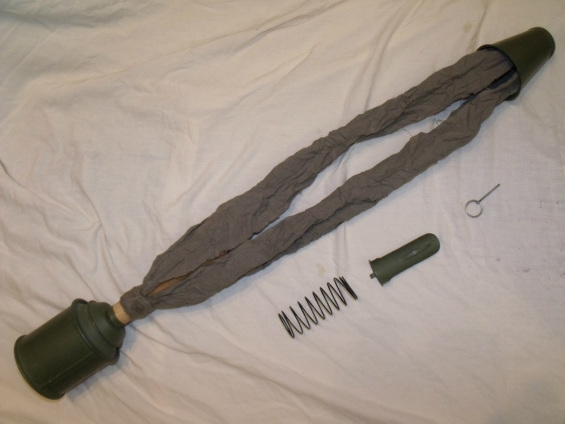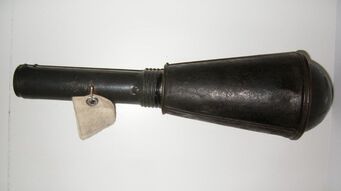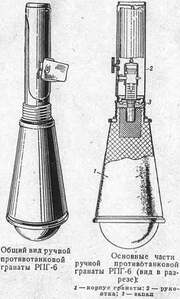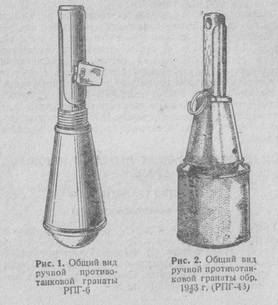Soviet weapons of the Great Patriotic War 1941-45.
In the 13th Guards we have a selection of weapons that would have been used in a Soviet Rifle regiment of the period. The weapons on our displays are original pre or war time examples and are deactivated under UK firearms legistation. We also have a selection of weapons for blank firing use in our firing and battle re enactment displays.
Members receive progressive and refresher instruction on the safe use of firearms under our adopted protocols and codes of practice. Members who do not undergo annual firearms training or adhere to protocols or demonstrate safe weapon handling will not be allowed to participate in firing displays.
Members receive progressive and refresher instruction on the safe use of firearms under our adopted protocols and codes of practice. Members who do not undergo annual firearms training or adhere to protocols or demonstrate safe weapon handling will not be allowed to participate in firing displays.
Model 1895 Nagant Revolver.
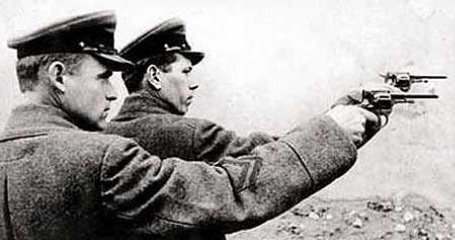
NKVD officers practice with Nagant pistols.
The Nagant Revolver pistol was originally co designed by the Belgian Emile and Leon Nagant brothers and dated back to 1878.
(Leon Nagant, was also a co designer of the Model 1891 3 line rifle, know by the Western designation as the Model 1891 Mosin Nagant rifle.
The revolver was initially produced under licence in Russia, who produced it in such numbers that its output exceeded all other carried out elsewhere, that it is now considered a Russian weapon. The first were produced at the state arsenal at Tula in 1895.
The revolver had an unusual concept, designed to increase the weapons velocity. The bullet was fully recessed in the cartridge case and when the trigger was depressed, the revolving cylinder cammed forward so that the cartridge engaged with the breach.The end of the cartridge formed a gas seal between the cylinder and barrel, which minimized the loss of propellant gases.
(Leon Nagant, was also a co designer of the Model 1891 3 line rifle, know by the Western designation as the Model 1891 Mosin Nagant rifle.
The revolver was initially produced under licence in Russia, who produced it in such numbers that its output exceeded all other carried out elsewhere, that it is now considered a Russian weapon. The first were produced at the state arsenal at Tula in 1895.
The revolver had an unusual concept, designed to increase the weapons velocity. The bullet was fully recessed in the cartridge case and when the trigger was depressed, the revolving cylinder cammed forward so that the cartridge engaged with the breach.The end of the cartridge formed a gas seal between the cylinder and barrel, which minimized the loss of propellant gases.
Models TT30 & TT 33 Tokarev 7.62 Pistols.
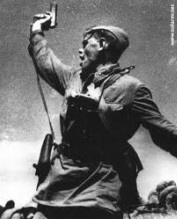
The TT 30 was the first automatic pistol to be produced in the Soviet Union and was designed by Fedor Tokarev. Adopted in 1930 production did not actually start until 1933. Developmental changes were introduced in 1934 and 1935 and the weapon became known as the TT33. (Manufactured at the state arsenal at Tula, hence Tula Tokarev model 1933) Production of the TT33 began in 1936.
It incorporated a recoil operated action and swinging link system of operation, similar to the US Model 1911 Colt single action, semi automatic pistol designed by John Browning. The TT33 also incorporated some unusual features in its design. The hammer and spring components etc were combined in a single removable module fitted into the rear edge of the grip. The barrel locking lugs encompassed the whole of the barrel, making it easier to manufacture and maintain in the field. To minimise ammunition feed stoppages, feed lips were machined into the main receiver, thus reducing misfeeds often caused by damaged magazines lips.
The pistol was copied by several Communist Satellite countries and remained in service in the Soviet Union until it was replaced in 1952 by the Makarov automatic pistol.
It incorporated a recoil operated action and swinging link system of operation, similar to the US Model 1911 Colt single action, semi automatic pistol designed by John Browning. The TT33 also incorporated some unusual features in its design. The hammer and spring components etc were combined in a single removable module fitted into the rear edge of the grip. The barrel locking lugs encompassed the whole of the barrel, making it easier to manufacture and maintain in the field. To minimise ammunition feed stoppages, feed lips were machined into the main receiver, thus reducing misfeeds often caused by damaged magazines lips.
The pistol was copied by several Communist Satellite countries and remained in service in the Soviet Union until it was replaced in 1952 by the Makarov automatic pistol.
TT 30 Pistol.
Outwardly there is little difference in appearance between the TT30 and the TT33 as the developmental changes were mainly internal. Externally there are subtle differences on the pistol grip and the trigger shape. The main visual difference is that the TT30 has a removable plate on the rear of the pistol grip strap, which houses the trigger spring.
TT 33 Pistol.
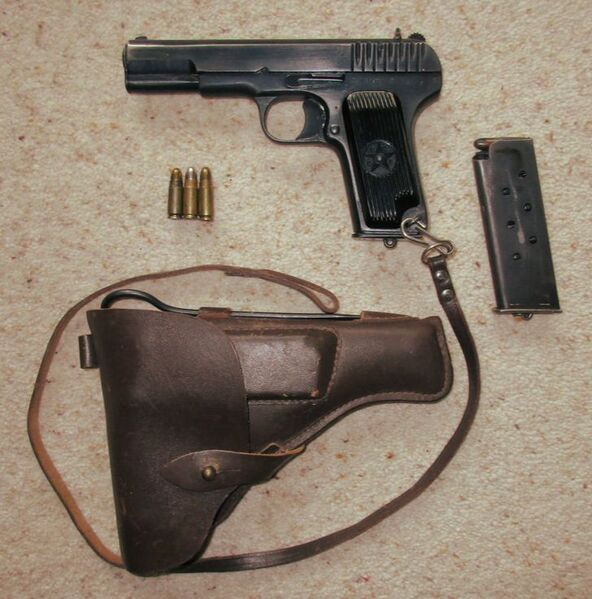
TT33 Pistol 1943 dated.
TT30 & TT33 specifications.
Calibre: 7.62 x 25 mm P.
Operation: Recoil/swinging link.
Weight: 0.83 Kg.
Length: 196 mm.
Velocity: 482 mtr p/sec.
Magazine: 8 round box.
Effective range: 25-50 mtrs.
Model PPSh 1941 7.62 Submachine gun.
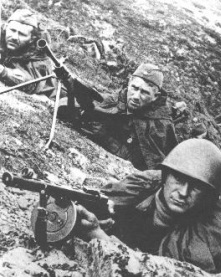
Pistolyet Pulyemet Shpagina Obr 1941.
The PPD 34/38 and 40, designed by Vasily Degtyaryev was the standard pre war submachine gun of the Red Army. The submachine gun was initially viewed by the Soviets as a police weapon, producing only 3170 between 1935 and 1939.The weapons full potential was not realised until the Winter War 1939-40, where the Finns demonstrated effective tactics against the Soviets using their own submachine gun, the Suomi 31.
The PPD was a well made gun but was expensive to manufacture, and was not suitable to meet the demands for wartime production.
Designer Georgii Shpagin developed the PPSh 41 weapon to meet the needs of mass production in 1941 and came into full production in early 1942. As far as possible it was made from sheet metal stampings, welding and riveting. Early models had a complicated tangent back sight, graded from 100-500 metres, which was replaced with a two aperture flip sight. It was a very rugged weapon and could withstand the harsh conditions in the field on the Eastern Front. Both the PPD and PPSh operated on the blow back/open bolt principle and could fire in single and auto fire modes.
The PPSh 41 could be used with either a 71 round drum or 35 round box magazine and it had selective fire for either single or automatic fire. It was issued in vast numbers and later in the war whole companies were armed with the weapons, often riding into battle on the backs of tanks and dismounting for the final assault.
It was also favoured by the Germans, who captured large amounts and could be used to fire the German 7.63 Mauser pistol round. Numbers of PPSh were rechambered to use the German 9mm and Parabellum rounds. It was later copied by other Communist Satellite countries. It was nicknamed by the troops as " Peh Peh Shah".
Below are three images of the PPD submachine gun for comparison to its successor the PPSh 41.
Top: PPD 34. Centre: PPD 34/38. Bottom: PPD 40.
The PPD 34/38 and 40, designed by Vasily Degtyaryev was the standard pre war submachine gun of the Red Army. The submachine gun was initially viewed by the Soviets as a police weapon, producing only 3170 between 1935 and 1939.The weapons full potential was not realised until the Winter War 1939-40, where the Finns demonstrated effective tactics against the Soviets using their own submachine gun, the Suomi 31.
The PPD was a well made gun but was expensive to manufacture, and was not suitable to meet the demands for wartime production.
Designer Georgii Shpagin developed the PPSh 41 weapon to meet the needs of mass production in 1941 and came into full production in early 1942. As far as possible it was made from sheet metal stampings, welding and riveting. Early models had a complicated tangent back sight, graded from 100-500 metres, which was replaced with a two aperture flip sight. It was a very rugged weapon and could withstand the harsh conditions in the field on the Eastern Front. Both the PPD and PPSh operated on the blow back/open bolt principle and could fire in single and auto fire modes.
The PPSh 41 could be used with either a 71 round drum or 35 round box magazine and it had selective fire for either single or automatic fire. It was issued in vast numbers and later in the war whole companies were armed with the weapons, often riding into battle on the backs of tanks and dismounting for the final assault.
It was also favoured by the Germans, who captured large amounts and could be used to fire the German 7.63 Mauser pistol round. Numbers of PPSh were rechambered to use the German 9mm and Parabellum rounds. It was later copied by other Communist Satellite countries. It was nicknamed by the troops as " Peh Peh Shah".
Below are three images of the PPD submachine gun for comparison to its successor the PPSh 41.
Top: PPD 34. Centre: PPD 34/38. Bottom: PPD 40.
PPSh 41 SMG.
PPSh 41 SMG.
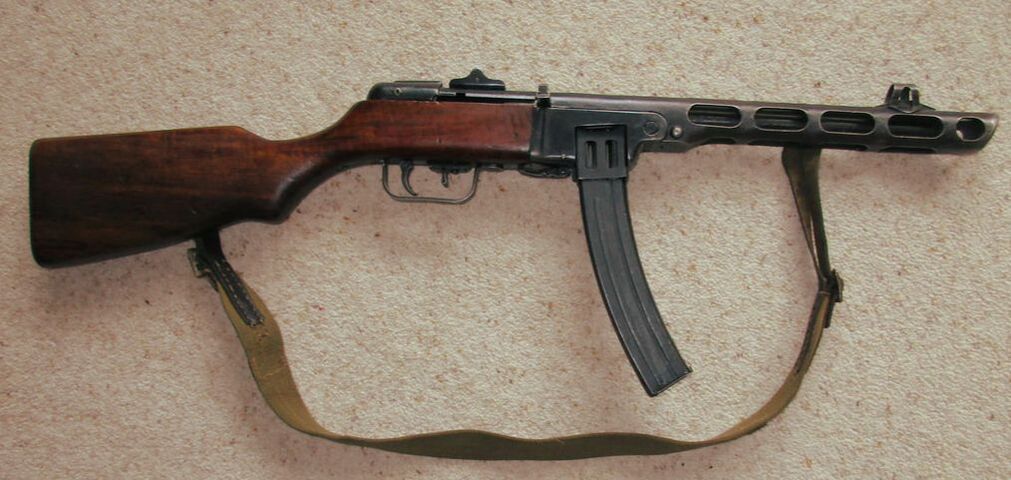
PPSh 41 with 35 round box magazine. The magazine that was manufactured during the first year of production was made of a thin gauge metal, which required strengthening ribbing. Thereafter, the magazines were made of a thicker gauge metal and which obviated the ribbing process.
Calibre: 7.62 x 25 mm P. Operation: Blowback/open bolt. Weight loaded: 5.4 kg.
Length: 828 mm. Velocity: 488 mtrs p/sec. Capicity: 35 or 71 round magazine.
Effective range: 100-150 mtrs Cyclic Rate of fire: 900 rounds p/min. Sights: 100-200mtrs.
Model 1942/43 PPS 7.62 Submachine gun.
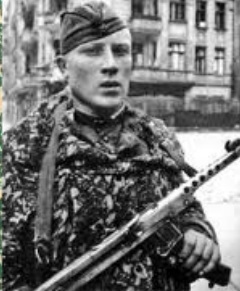
Soviet scout in Berlin May1945.
Pistolyet Pulyemet Sudaryeva Obr 1942/43.
Designed by Alexei Sudarev during the Siege of Leningrad, and was created using materials that were available in the besieged city at the time. It was a simple and robust weapon, of a blow back/open bolt operating principle and used sheet metal stamping's and held together by welds, rivets and pins and incorporated a simple metal folding butt. Combat trials took place during the siege in early 1942 and was adopted after some minor improvements for wide spread use by the Red Army in 1943.
It had a 35 round box magazine and could only fire in automatic mode and was produced along side the PPSh 41, but not in the same numbers. Given it's compactness,the weapon was ideally suited for close quarter and urban fighting, reconnaissance/scouts as well as tank and AFV crews.
Again, the Germans used captured stocks and the weapon was later copied by other Communist Satellite countries. It was nicknamed by the troops as the "Balalaika" after the musical instrument.
Designed by Alexei Sudarev during the Siege of Leningrad, and was created using materials that were available in the besieged city at the time. It was a simple and robust weapon, of a blow back/open bolt operating principle and used sheet metal stamping's and held together by welds, rivets and pins and incorporated a simple metal folding butt. Combat trials took place during the siege in early 1942 and was adopted after some minor improvements for wide spread use by the Red Army in 1943.
It had a 35 round box magazine and could only fire in automatic mode and was produced along side the PPSh 41, but not in the same numbers. Given it's compactness,the weapon was ideally suited for close quarter and urban fighting, reconnaissance/scouts as well as tank and AFV crews.
Again, the Germans used captured stocks and the weapon was later copied by other Communist Satellite countries. It was nicknamed by the troops as the "Balalaika" after the musical instrument.
PPS SMG.
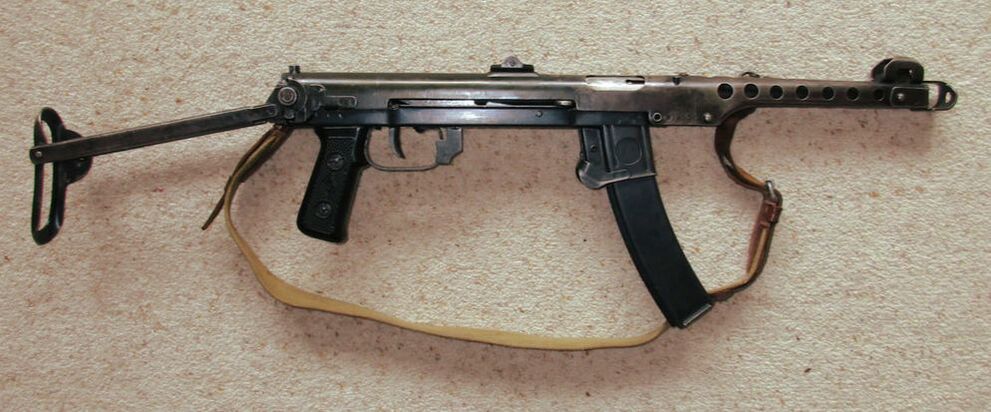
Calibre: 7.62 x 25 mm P. Operation: blow back/open bolt. Weight loaded: 3.9 Kg.
Length: 606 mm, butt extended 808 mm. Velocity: 488 mtrs p/sec. Capacity: 35 round box magazine.
Effective range: 100-200 mtrs. Cyclic rate of fire: 800 rounds p/min. Sights: 100-200 mtrs.
Model 1891/30 Mosin Nagant 7.62 Rifle.
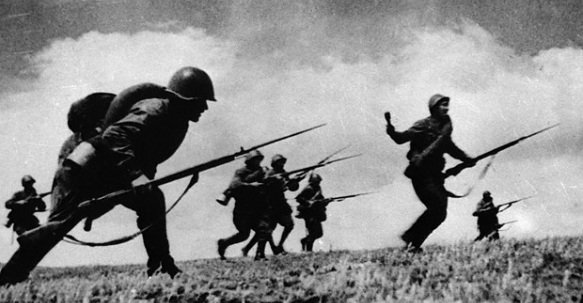
Vintovka Mosina 1891/30.
The original official designation for the weapon when formally adopted by the Russian military in 1891 was The 3-line rifle Model 1891 and use of the designation as the Mosin Nagant is a Western misnomer.
In Soviet Russia, the rifle was only officially named the "Mosin's rifle" in 1924 and particular models were still designated by a year only i.e. Model 1938 & Model 1944.
During its production there have been several variations from the original rifle, the most common being the Model 1891/30,which refers to a modernized design introduced in 1930. The rifle remains as one of the most mass produced in history.
The weapon was born out of the need to develope a modern infantry rifle following the Russian-Turkish War 1877-78. In 1889 three such rifles were submitted to a commission for evaluation by Capt Sergei Mosin, Captain Zinoviev, both of the Russian Imperial Army and Belgian Leon Nagant. In 1891 at the end of the evaluation the commission voted marginally in favour of Mosin's design over Nagant's and both were required to submit a final design. A patent dispute invoked by Nagant claimed specifics of his designs had been adopted in the Mosin design was resolved by Nagant receiving the same prize money as Mosin. As the final design was mainly of Mosin's and other Russian contributors, the rifle was adopted as The 3-line rifle Model 1891 (refers to the the calibre being the equivalent of 3 lines in the Imperial Russian system of measurement i.e. 1 line being 1/10 of an inch or 2.54 mm) and went into production at state arsenals in 1892. Leon Nagant remained the major contractor for the Russian Government, who later with is brother of Emile Nagant, co designed the Model 1895 Nagant revolver.
It was an unremarkable weapon, however it served both the Russian Imperial then the Red Armies until the early 1950's.
It was a bolt action weapon, the bolt of which was of an unnecessarily complicated design and had a five round internal magazine. In 1930 some improvements were made to the rifle i.e. the fore stock, improved bayonet fitting, sling attachment, fore sight and metrication of the rear sights and this became known as the Model 1891/30 and was the most prolific mark of Mosin Nagant rifle produced.
It was also widely used during the Great Patriotic War as a sniper rifle and early versions were fitted with either a X 4 PE or PEM sniper telescope, a Russian copy of the German Ziess sniper scope. Later, a smaller and simplified X 3.5 PU scope was produced for the rifle. The bolt on the sniper variants were longer and turned down, so it could be operated without interfering with the scope, which was mounted above the receiver.
It was fitted with a rather archaic looking 17 inch long bayonet, which appears to have been permanently attached to the rifle.
The original official designation for the weapon when formally adopted by the Russian military in 1891 was The 3-line rifle Model 1891 and use of the designation as the Mosin Nagant is a Western misnomer.
In Soviet Russia, the rifle was only officially named the "Mosin's rifle" in 1924 and particular models were still designated by a year only i.e. Model 1938 & Model 1944.
During its production there have been several variations from the original rifle, the most common being the Model 1891/30,which refers to a modernized design introduced in 1930. The rifle remains as one of the most mass produced in history.
The weapon was born out of the need to develope a modern infantry rifle following the Russian-Turkish War 1877-78. In 1889 three such rifles were submitted to a commission for evaluation by Capt Sergei Mosin, Captain Zinoviev, both of the Russian Imperial Army and Belgian Leon Nagant. In 1891 at the end of the evaluation the commission voted marginally in favour of Mosin's design over Nagant's and both were required to submit a final design. A patent dispute invoked by Nagant claimed specifics of his designs had been adopted in the Mosin design was resolved by Nagant receiving the same prize money as Mosin. As the final design was mainly of Mosin's and other Russian contributors, the rifle was adopted as The 3-line rifle Model 1891 (refers to the the calibre being the equivalent of 3 lines in the Imperial Russian system of measurement i.e. 1 line being 1/10 of an inch or 2.54 mm) and went into production at state arsenals in 1892. Leon Nagant remained the major contractor for the Russian Government, who later with is brother of Emile Nagant, co designed the Model 1895 Nagant revolver.
It was an unremarkable weapon, however it served both the Russian Imperial then the Red Armies until the early 1950's.
It was a bolt action weapon, the bolt of which was of an unnecessarily complicated design and had a five round internal magazine. In 1930 some improvements were made to the rifle i.e. the fore stock, improved bayonet fitting, sling attachment, fore sight and metrication of the rear sights and this became known as the Model 1891/30 and was the most prolific mark of Mosin Nagant rifle produced.
It was also widely used during the Great Patriotic War as a sniper rifle and early versions were fitted with either a X 4 PE or PEM sniper telescope, a Russian copy of the German Ziess sniper scope. Later, a smaller and simplified X 3.5 PU scope was produced for the rifle. The bolt on the sniper variants were longer and turned down, so it could be operated without interfering with the scope, which was mounted above the receiver.
It was fitted with a rather archaic looking 17 inch long bayonet, which appears to have been permanently attached to the rifle.
Mosin Nagant Rifle.
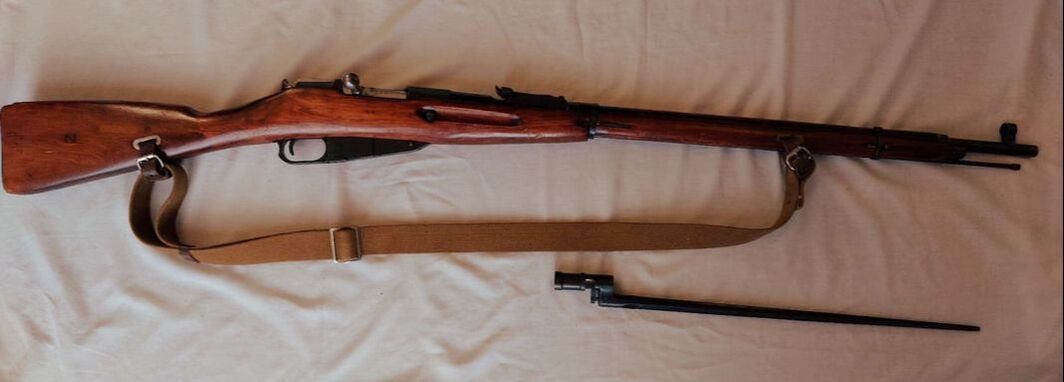
Top: A 1891/30 rifle with octagonal receiver dated 1930 and standard bayonet..
Calibre: 7.62 x 54R mm. Operation: Bolt action. Weight: 4 Kg.
Length: 1232 mm. Velocity: 766 mtrs p/sec. Capacity: 5 round internal magazine.
Range: Max 2000mtrs. Effective up to 800mtrs. Practical rate of fire: 10-12 rounds p/min. Sights: 100 - 2000 mtrs.
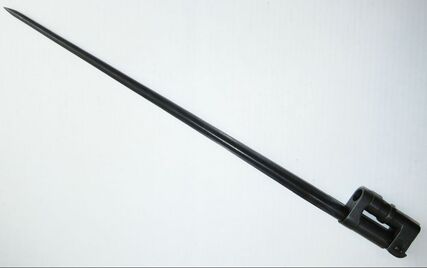
Experimental folding bayonet attachment for M1891/30 Rifle
In 1943 an experimental folding bayonet attachment was
trialled for use with the Mosin Nagant 1891/30 rifle. The socket was the same as the standard bayonet socket but with attached lobes and a swivel pin, which held the spring loaded base of the bayonet and locked it position when folded. To fix the bayonet, downward pressure on the spring swivel disengaged it from the lobes and the bayonet could be swung into position and was secured in place by a locking ring over the end of the muzzle. It doesn't appeared that it was ever adapted for the rifle.
As the war progressed the M1891 rifle with bayonet fitted was considered somewhat cumbersome, particularly during urban combat and the M1938 Mosin Nagant Carbine was considered to be more appropriate. However, it was produced without any bayonet fittings. The same fitment principle of the experimental folding bayonet was adopted to be permanently fixed for the M1938 Carbine. Minor adjustments were also made to the fore stock to accommodate the side folding bayonet when folded, which was designated M1944 Mosin Nagant Carbine.
In 1943 an experimental folding bayonet attachment was
trialled for use with the Mosin Nagant 1891/30 rifle. The socket was the same as the standard bayonet socket but with attached lobes and a swivel pin, which held the spring loaded base of the bayonet and locked it position when folded. To fix the bayonet, downward pressure on the spring swivel disengaged it from the lobes and the bayonet could be swung into position and was secured in place by a locking ring over the end of the muzzle. It doesn't appeared that it was ever adapted for the rifle.
As the war progressed the M1891 rifle with bayonet fitted was considered somewhat cumbersome, particularly during urban combat and the M1938 Mosin Nagant Carbine was considered to be more appropriate. However, it was produced without any bayonet fittings. The same fitment principle of the experimental folding bayonet was adopted to be permanently fixed for the M1938 Carbine. Minor adjustments were also made to the fore stock to accommodate the side folding bayonet when folded, which was designated M1944 Mosin Nagant Carbine.
Dyakonov Rifle Grenade Launcher Caliber 40.8mm/1.6 in.
It was originally designed in 1916 by Capt. Mikhail Dyakonov of the Russian Imperial Army for use with the standard Mosin Nagant M1891 rifle. Due to the ensuing Russian Revolution and Civil War it did not actually come into service until 1928 with the RKKA for use with the Mosin Nagant M1891 and the subsequent M1891/30 rifle respectively. By then the weapon had been improved slightly with better sights and improved range.
At the start of the war the standard 12 man infantry section was based on the December 1935 TO&E's i.e Section leader, observer/scout (section 2iC), 2 man LMG team, 2 man grenadier(armed with Dyakonov launcher) and 6 riflemen. Due to the disastrous losses of manpower during 1941-42, the infantry section was revised and reduced to 10 men and subsequently to 9 men by December 1942, whereby due to the operational effectiveness value of the weapon i.e. limited range,accuracy and the charge being little more than a standard hand grenade, the Dyakonov launcher team was rendered obsolete and deleted from the infantry section.
The Dyakonov launcher cup, which was rifled was attached to the muzzle of a standard M1891/30 rifle using the bayonet fitting lug and a telescopic bipod and a quadrant sight were attached to the rifle stock. The types of grenades used were anti-personnel fragmentation, smoke (various colours),night signal flare rounds and a simulated grenade round. Unusually, unlike some other rifle grenade launchers of other armies which used blank cartridges, the Dyakonov was capable of being fired by using a live cartridge.
At the beginning of the 1942, the VPGS-41 Serdyuk rifle-type anti-tank grenade came into service, which consisted of a muzzle attachment and a rear elevation sight attachment. The grenade had a streamlined shaped charge, fuse, stabilizer fin and a long spigot rod, which was inserted into the barrel of a rifle. A blank cartridge was used to discharge the grenade. Direct firing range was up to 60 metres and at an angle of 40 degrees elevation up to 170 meters. The effective range and accuracy were low, quite often the fuse worked prematurely and the ramrod inserted into the muzzle tended to damage the barrel after a short period of time and it was removed from service and production before the end of 1942.
In 1944, in an attempt to revive the rifle grenade concept, the VKG-40 (40 mm) anti-tank shaped charge grenade launcher was introduced. However, due to the low accuracy, effectiveness of the rifle grenade and limited range it was produced in limited numbers only. In 1944-45 Soviet engineers developed rifle AT grenades VG-44 and VG-45 for the Mosin Nagant carbines.
Specifications: Dyakonov Rifle Grenade Launcher Caliber 40.8mm/1.6 in.
Type: Rifle grenade launcher. Length: UKAP. Weight: launcher 2.9 lbs (1.3 kg); bipod 4.9 lbs (2.2 kg); sighting device 1.5 lbs (0.7 kg); M91/30 rifle with grenade launcher 18.1 lbs (8.2 kg)
Range: Minimum:170 mtrs. Maximum range: 850 mtrs. Calibre: (40.8 mm/1.6in.Grenade Weight: frag 0.36 kg/0.8ibs. flare 0.3-0.4 lbs 0.13-0.17 kg/ 0.3-0.4 lbs. Capacity: 1 round. Fire mode: Manual.
It was originally designed in 1916 by Capt. Mikhail Dyakonov of the Russian Imperial Army for use with the standard Mosin Nagant M1891 rifle. Due to the ensuing Russian Revolution and Civil War it did not actually come into service until 1928 with the RKKA for use with the Mosin Nagant M1891 and the subsequent M1891/30 rifle respectively. By then the weapon had been improved slightly with better sights and improved range.
At the start of the war the standard 12 man infantry section was based on the December 1935 TO&E's i.e Section leader, observer/scout (section 2iC), 2 man LMG team, 2 man grenadier(armed with Dyakonov launcher) and 6 riflemen. Due to the disastrous losses of manpower during 1941-42, the infantry section was revised and reduced to 10 men and subsequently to 9 men by December 1942, whereby due to the operational effectiveness value of the weapon i.e. limited range,accuracy and the charge being little more than a standard hand grenade, the Dyakonov launcher team was rendered obsolete and deleted from the infantry section.
The Dyakonov launcher cup, which was rifled was attached to the muzzle of a standard M1891/30 rifle using the bayonet fitting lug and a telescopic bipod and a quadrant sight were attached to the rifle stock. The types of grenades used were anti-personnel fragmentation, smoke (various colours),night signal flare rounds and a simulated grenade round. Unusually, unlike some other rifle grenade launchers of other armies which used blank cartridges, the Dyakonov was capable of being fired by using a live cartridge.
At the beginning of the 1942, the VPGS-41 Serdyuk rifle-type anti-tank grenade came into service, which consisted of a muzzle attachment and a rear elevation sight attachment. The grenade had a streamlined shaped charge, fuse, stabilizer fin and a long spigot rod, which was inserted into the barrel of a rifle. A blank cartridge was used to discharge the grenade. Direct firing range was up to 60 metres and at an angle of 40 degrees elevation up to 170 meters. The effective range and accuracy were low, quite often the fuse worked prematurely and the ramrod inserted into the muzzle tended to damage the barrel after a short period of time and it was removed from service and production before the end of 1942.
In 1944, in an attempt to revive the rifle grenade concept, the VKG-40 (40 mm) anti-tank shaped charge grenade launcher was introduced. However, due to the low accuracy, effectiveness of the rifle grenade and limited range it was produced in limited numbers only. In 1944-45 Soviet engineers developed rifle AT grenades VG-44 and VG-45 for the Mosin Nagant carbines.
Specifications: Dyakonov Rifle Grenade Launcher Caliber 40.8mm/1.6 in.
Type: Rifle grenade launcher. Length: UKAP. Weight: launcher 2.9 lbs (1.3 kg); bipod 4.9 lbs (2.2 kg); sighting device 1.5 lbs (0.7 kg); M91/30 rifle with grenade launcher 18.1 lbs (8.2 kg)
Range: Minimum:170 mtrs. Maximum range: 850 mtrs. Calibre: (40.8 mm/1.6in.Grenade Weight: frag 0.36 kg/0.8ibs. flare 0.3-0.4 lbs 0.13-0.17 kg/ 0.3-0.4 lbs. Capacity: 1 round. Fire mode: Manual.
Models 1938 and 1944 Mosin Nagant 7.62 Carbine.
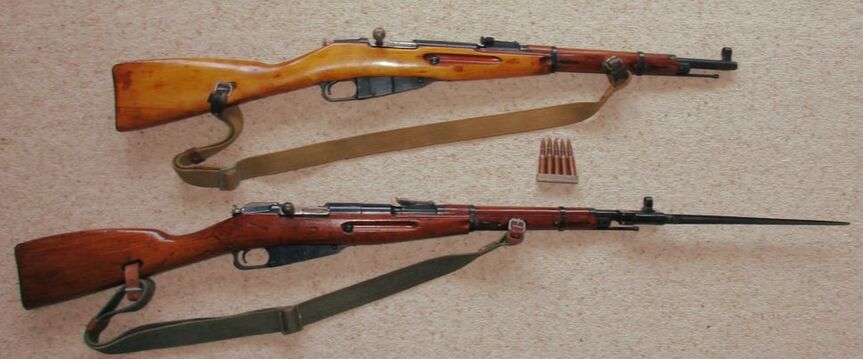
Mosina Karabin. Top; Model 38 Carbine. Bottom: Model 1944 carbine.
At the time of the Mosin Nagant's introduction in 1891, a Dragoon model was also produced. It was nearly 6.5 cms shorter and 0.4kg lighter than the rifle variant and was intended for mounted troops. In 1907 a carbine version was produced, which was nearly 29 cms shorter and almost a kilogram lighter, It was intended for cavalry, artillery, engineers, signallers use. It did not have a fitting for a bayonet.
In 1938 a carbine based on the Model 1891/30 rifle was introduced for cavalry, crew served weapons and second echelon troops. The barrel and stock were shortened and the carbines overall length was 1016 mm. A bayonet could not be fitted to the carbine.
In late 1944 another variant appeared, which was basically a Model 1938 carbine with a permanently affixed side folding bayonet. This model remained in service until 1955.
The characteristics were the same as the 1891/30 rifle excepting the following.
Weight: 3.55 Kg Length: 1016 mm. Range: Effective 400mtrs.
Practical rate of fire: 10-12 rounds p/min. Sights: 100 - 1000mtrs.
Model SVT 1940 7.62 Self loading rifle.
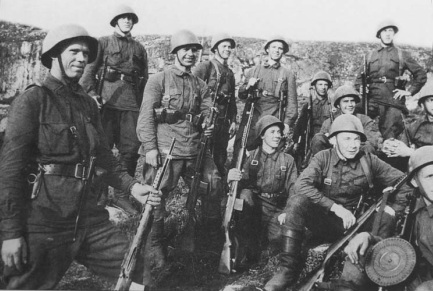
Samozariadniya Vintovka Tokareva 1940. (Self loading rifle Tokarev).
In an effort to increase fire power at rifle section level, the Soviets in the late 1920s were researching and developing self loading weapons. As early as 1930, designers Sergei Simonov and Fyedor Tokarev respectively began work on gas operated self loading rifles. In 1935 following trials involving weapons developed by Simonov and Tokarev, the following year the AVS 36 (Avtomaticheskaya Vintovka Simonova 36 - Automatic Rifle Simonov 1936) was accepted into service with the Red Army.
The weapon proved heavy, had a fierce recoil, which made it inaccurate to fire, was subject to breakages and required extensive maintenance of the complex mechanism in the field.
In May 1938 the AVS 36 was withdrawn and Fyedor Tokarev's design, SVT 38 was accepted into service to replace the AVS 36. The SVT 38 was used during the Winter War and proved to be unpopular with the troops as it suffered from the same problems that blighted the AVS 36 and was therefore withdrawn from service in 1939.
In 1940 a modified version, the SVT 40 was adopted for use. It operated on the same principles of tapping off propellant gasses to operate a piston and a locking block system which recessed with the receiver. It had a 10 round magazine, unlike the 15 round AVS 36. It was basically a sound weapon, however it still suffered some of the problems of the AVS and SVT 38 i.e. the fierce recoil and muzzle blast and resulting poor accuracy and still required high maintenance in the field. It was generally issued to NCOs and more carefully trained soldiers. It could be fitted with a 23cm bladed knife bayonet.
A sniper variant was adopted and the PU x 3.5 compact telescopic sight was developed for the weapon. Because of its recoil and poor accuracy in comparison with the bolt action rifle, it had a short service run of 51,710 examples being made and was generally withdrawn by 1943. The total production of the SVT-38/40 was 5,772,085 rifles including the sniper variant.
A selective automatic fire variant, the AVT 40 was briefly adopted, however it was uncontrollable in auto fire, subject to breakages and the 10 round magazine could not sustain the automatic fire role. Reportedly a carbine version was produced for airborne troops, the SKT 40 and it was unlikely any produced did not see field service. The Germans and Finns captured large stocks of SVT 40s and used them and the Germans adopted the gas operated mechanism and incorporated it into their own Gewehr 43 rifle.
Total production of the SVT 38/40 was SVT 38: 150,000; SVT 40: 1,600,000, of which 51,710 were the SVT-40 sniper variant.
In an effort to increase fire power at rifle section level, the Soviets in the late 1920s were researching and developing self loading weapons. As early as 1930, designers Sergei Simonov and Fyedor Tokarev respectively began work on gas operated self loading rifles. In 1935 following trials involving weapons developed by Simonov and Tokarev, the following year the AVS 36 (Avtomaticheskaya Vintovka Simonova 36 - Automatic Rifle Simonov 1936) was accepted into service with the Red Army.
The weapon proved heavy, had a fierce recoil, which made it inaccurate to fire, was subject to breakages and required extensive maintenance of the complex mechanism in the field.
In May 1938 the AVS 36 was withdrawn and Fyedor Tokarev's design, SVT 38 was accepted into service to replace the AVS 36. The SVT 38 was used during the Winter War and proved to be unpopular with the troops as it suffered from the same problems that blighted the AVS 36 and was therefore withdrawn from service in 1939.
In 1940 a modified version, the SVT 40 was adopted for use. It operated on the same principles of tapping off propellant gasses to operate a piston and a locking block system which recessed with the receiver. It had a 10 round magazine, unlike the 15 round AVS 36. It was basically a sound weapon, however it still suffered some of the problems of the AVS and SVT 38 i.e. the fierce recoil and muzzle blast and resulting poor accuracy and still required high maintenance in the field. It was generally issued to NCOs and more carefully trained soldiers. It could be fitted with a 23cm bladed knife bayonet.
A sniper variant was adopted and the PU x 3.5 compact telescopic sight was developed for the weapon. Because of its recoil and poor accuracy in comparison with the bolt action rifle, it had a short service run of 51,710 examples being made and was generally withdrawn by 1943. The total production of the SVT-38/40 was 5,772,085 rifles including the sniper variant.
A selective automatic fire variant, the AVT 40 was briefly adopted, however it was uncontrollable in auto fire, subject to breakages and the 10 round magazine could not sustain the automatic fire role. Reportedly a carbine version was produced for airborne troops, the SKT 40 and it was unlikely any produced did not see field service. The Germans and Finns captured large stocks of SVT 40s and used them and the Germans adopted the gas operated mechanism and incorporated it into their own Gewehr 43 rifle.
Total production of the SVT 38/40 was SVT 38: 150,000; SVT 40: 1,600,000, of which 51,710 were the SVT-40 sniper variant.
SVT 40.

A later model SVT 40 with the two port muzzle brake. Earlier models had a six slot muzzle brake. See below image.
Calibre: 7.62 x 54 R. Operation: gas with rotating locking bolt. Weight: 3.89 Kg.
Length: 1222 mm. Velocity: 830 mtrs p/sec. Capacity: 10 round box magazine.
Range: Max 1500mtrs. Effective 400mtrs. Pratical rate of fire: 20-25 rounds p/min. Sights:100 -1500 mtrs.
Model 1928 RPDP or (DP 28) 7.62 Light machine gun.
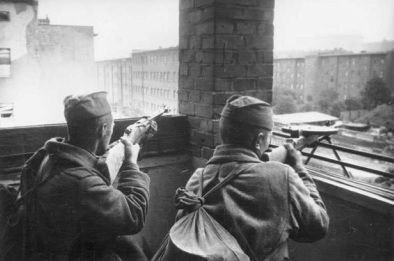
Rushnoi Pulyemyet Degtyaryeva Pekhotnyi 1928 (Weapon Automatic Degtyaryev Infantry or DP 28)
The gun designer Vasily Degtyaryev began work on the gas operated design in 1921, and it was put into limited production in 1926. After two years trial it was accepted for service in 1928. It was a
reasonably robust weapon and of simple construction, incorporating only 65 parts. Not surprisingly it had it defects, mainly caused by over heating and associated failure of the piston spring, which caused stoppages. Early models had finned barrels to dissapate heat. To change the barrel was a relatively slow process and required a special tool and the over heating problem was never really resolved, but was minimised by restricting the rate of fire and the open bolt operation assisted cooling. It only had an automatic fire operation. It used a clockwork 47 round drum magazine which was very susceptible to damage in the field.
In 1944 an improved version was introduced, the DPM 44 (or Degtyaryeva Pekhotnyi Modernizirovanniy 1944). An improved bipod was fitted and the return spring was located into a tube and designed to reduce heat induced weakening. The end of this tube protuded out the rear of the receiver and a pistol grip was added to aid stability. It was nicknamed by the troops as the " Partefon", i.e. the Russian word for a gramaphone, due to the shape of the drum magazine resembling the shape of a gramaphone record.
The gun designer Vasily Degtyaryev began work on the gas operated design in 1921, and it was put into limited production in 1926. After two years trial it was accepted for service in 1928. It was a
reasonably robust weapon and of simple construction, incorporating only 65 parts. Not surprisingly it had it defects, mainly caused by over heating and associated failure of the piston spring, which caused stoppages. Early models had finned barrels to dissapate heat. To change the barrel was a relatively slow process and required a special tool and the over heating problem was never really resolved, but was minimised by restricting the rate of fire and the open bolt operation assisted cooling. It only had an automatic fire operation. It used a clockwork 47 round drum magazine which was very susceptible to damage in the field.
In 1944 an improved version was introduced, the DPM 44 (or Degtyaryeva Pekhotnyi Modernizirovanniy 1944). An improved bipod was fitted and the return spring was located into a tube and designed to reduce heat induced weakening. The end of this tube protuded out the rear of the receiver and a pistol grip was added to aid stability. It was nicknamed by the troops as the " Partefon", i.e. the Russian word for a gramaphone, due to the shape of the drum magazine resembling the shape of a gramaphone record.
DP 28 LMG.
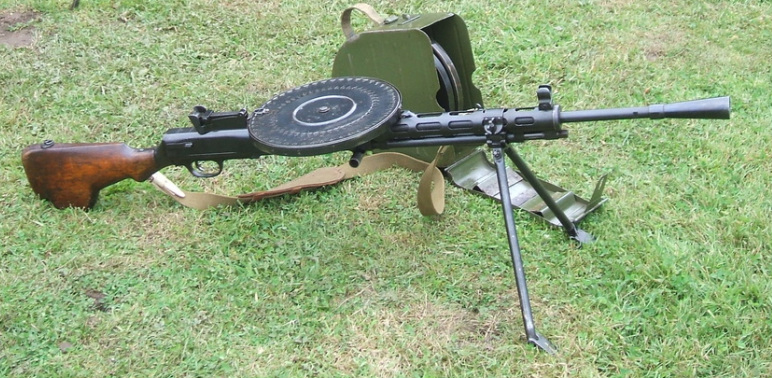
DP 28 with ammo can which holds three drum magazines.
Calibre: 7.62 x 54 R mm. Operation: Gas, open bolt, air cooled. Weight: 11.9 Kg. Length: 1265 mm.
Velocity: 645 mtrs p/sec. Capacity: 47 round drum magazine. Range: Max 1500 mtrs. Effective 1000 mtrs.
Cyclic rate of fire: 600 rounds p/min. Practical rate of fire: 80 rounds p/min. Sights: 100 - 1500 mtrs.
DP 28 & DPM 1944 and DT Tank and AFV variants.
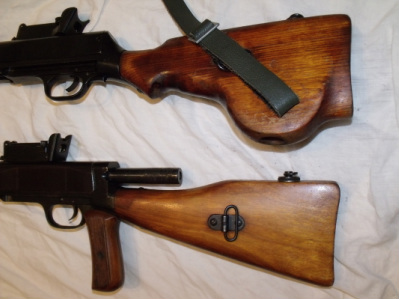
Detail of variants. Top: DP 28. Bottom: DPM 44.
A version of the DP 28 was developed for use in tanks and armoured fighting vehicles, namely the DT 28 ( Degtyaryeva Tankovoye 1928)
It was basically the same weapon and operated on the same principles, however it was adapted for use within the confines of a tank or AFV. It had a metal retractable butt and the magazine was smaller, but deeper and had a capacity of 60 rounds. A telescopic sight could be fitted for use inside a tank or AFV. In 1944 the modernised version, the DTM 44 was introduced at the same time as the DPM 44.It was often seen used with a bipod added and it was apparently popular as an infantry section LMG.
A variant for use in aircraft was designated as Degtyaryeva Aviatsionny DA 28 and DA-2 (tandem mounted in bombers),which was superseded by the ShKAS machine gun which had a much higher rate of fire.
Model 1944 DTM 7.62 Tank Light Machine Gun.
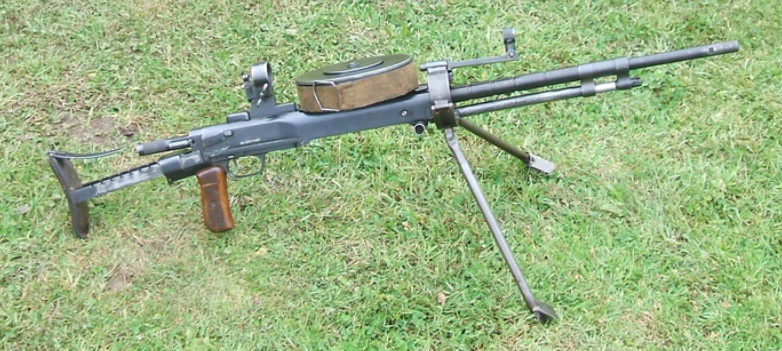
A model DTM 44 with bipod attachment for infantry section role.
Note: The circular metal device fixed to the rear sight, was a clamp for securing a telescopic sight when the gun was used inside a tank. It had a simple flip up sight for infantry/dismounted use. On the top of the butt was a hinged metal brace device, which could be flipped over on to the top of the users shoulder to give some extra stability when firering the gun.
The characteristics of the DT were the same as the DP excepting for the following.
Weight: 12.9 Kg. Length: 1181 mm. Velocity: 840 mtrs p/sec. Capacity: 60 round drum magazine.
Cyclic rate of fire: 600 rounds p/min.
Model 1910 Maxim 7.62 Medium Machine gun.
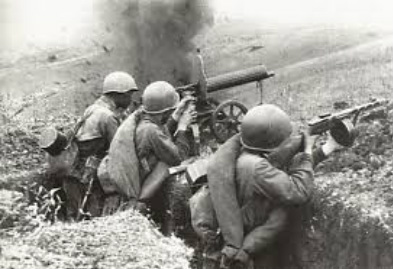
Pulyemet Maksima Obr 1910.
The Maxim 1910 was a direct copy of the original Maxim gun designed by Hiram Maxim at the end of the 19th Century. The Russians first produced their own version in 1907, which was chambered to fire the 7.62mm round. In 1910 the bronze water jacket version was replaced by a sheet steel one. The gun worked by short recoil and locking toggle operation and belt fed ammunition systems. It was an incredibly robust and reliable gun, which could absord rough handling and operated in the most adverse of conditions. However, this reliability was at a cost, its weight. The weight complete with mount and shield was 69Kg (153.1lb.)
A spoked wheeled mount, the Sokolov mount was usually used in conjunction with the gun, which could be dragged along by two men. Early Sokolov mounts had a foldable leg near each end of the wheel axle and together with the trail, the entire gun could be raised to fire over a parapet. During the Russian Civil War the gun was also mounted in a cart for mobility in Cavalry units. Known as the Tachanka, it also saw service in the early years of the Great Patriotic War. A quadruple anti-aircraft version and mount was also used in the GPW for use on vehicles and maritime vessels.
In 1930 designer Fyedor Tokarev made some minor improvements to the gun and was known as the MT 1910/30. The PM 1910 was the longest produced version of all the Maxim gun variants and remained in full scale production in the Soviet Union until the end of the GPW, despite the introduction of new air cooled machine guns such as the DS 39 and the Goryunov 43.
The Maxim 1910 was a direct copy of the original Maxim gun designed by Hiram Maxim at the end of the 19th Century. The Russians first produced their own version in 1907, which was chambered to fire the 7.62mm round. In 1910 the bronze water jacket version was replaced by a sheet steel one. The gun worked by short recoil and locking toggle operation and belt fed ammunition systems. It was an incredibly robust and reliable gun, which could absord rough handling and operated in the most adverse of conditions. However, this reliability was at a cost, its weight. The weight complete with mount and shield was 69Kg (153.1lb.)
A spoked wheeled mount, the Sokolov mount was usually used in conjunction with the gun, which could be dragged along by two men. Early Sokolov mounts had a foldable leg near each end of the wheel axle and together with the trail, the entire gun could be raised to fire over a parapet. During the Russian Civil War the gun was also mounted in a cart for mobility in Cavalry units. Known as the Tachanka, it also saw service in the early years of the Great Patriotic War. A quadruple anti-aircraft version and mount was also used in the GPW for use on vehicles and maritime vessels.
In 1930 designer Fyedor Tokarev made some minor improvements to the gun and was known as the MT 1910/30. The PM 1910 was the longest produced version of all the Maxim gun variants and remained in full scale production in the Soviet Union until the end of the GPW, despite the introduction of new air cooled machine guns such as the DS 39 and the Goryunov 43.
1910/30/41 MT Medium machine gun.
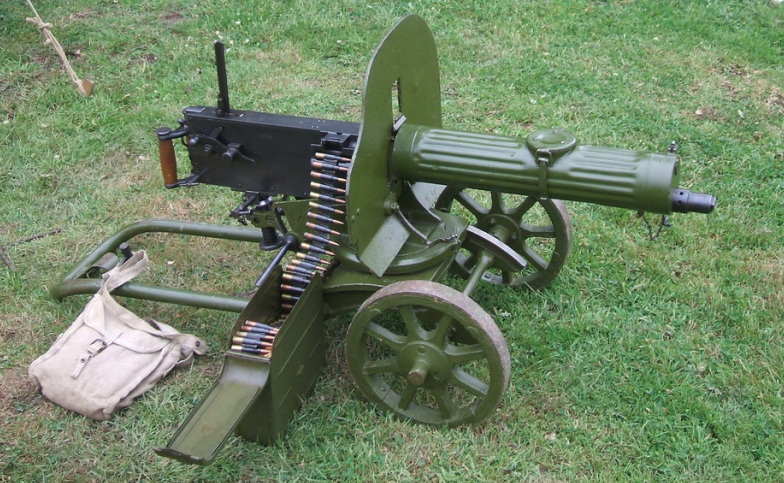
A MT 1910/30 version of the gun, distinguished by its filler cap on top of the water cooling jacket. The ammunition boxes contained 250 rounds and was used with both canvas and metal link belts. The canvas gunners pouch contained various tools for the guns maintenance.
Calibre: 7.62 x 54 R mm. Operation: water cooled, recoil and locking toggle. Length: 1107 mm.
Weight: Gun 23.8 Kg. Sokolov mount and shield 45.2 Kg. Velocity: 863 mtrs p/sec. Capacity: 250 round fabric or metal linked belt.
Range: Max 2700 mtrs. Effective 1000 mtrs. Cyclic rate of fire: 600 round p/min. Practical rate of fire: 250-300 rounds p/min. Sights: 0-2700 mtrs. Crew: Gunner & Asst Gunner.
Model 1941 PTRD and PTRS 14.5 Anti Tank Rifles.
Protivo Tankovoye Ruzhyo Degtyaryeva Obr 1941 and Protivo Tankovoye Ruzhyo Simonova Obr 1941 (Anti Tank Rifle Degtyaryev/Simonov 1941)

PTR-R (Rukavishnikov) 39 Anti Tank Rifle,designed by NV Rukavishnikov 1938, produced 1939.Number built:
15,000 ordered, cancelled only 5 built
In Service 1939 - 1940. Calibre 14.5x114mm, gas-operated semi auto action, detachable side mounted 5 round box magazine. Barrel Length 1,180 mm with bipod attachment.
The Soviets in comparison to armies in other countries were behind in the take up of a dedicated portable anti tank weapon. In 1939 they developed the Rukavishnikov 14.5 anti tank rifle, but it was complicated to make under war time conditions and was not produced in any quantity.
With the onset of war imminent, the Soviet rushed two designs into production. Simonov designed a semi automatic 14.5 mm version (PTRS 41) and Degtyaryev designed a 14.5 mm single shot bolt action version (PTRD 41) of the anti tank rifle.
Each used the BS-41 14.5 x 114 mm round, which had a tungsten carbide core and was of armour piercing incendiary construction, could penetrate armour angled up to 60 degrees, up to 35-40 mm at ranges of 300 metres or less. It was capable of penetrating the armour of all known enemy tanks at the start of the war in 1941. Each design had its drawbacks, the PTRD had a slower rate of fire and because of the foresight position on the left side of the muzzle, a left handed gunner would not be able able to aim it accurately! The PTRS automatic system was more susceptible to stoppages due to the ingress of dirt, as well as both designs having a fierce recoil and a highly visible muzzle blast!
The ATR's were ineffective against the frontal armour of the later war heavier Panther and Tiger tanks, but were used to engage the thinner side and rear armour, the tracks and wheels as well as aimed shots at the drivers and commanders vision blocks and at the tanks gun barrel in order to disable them. It would often take numerous shots to actually disable a heavier German tanks. They were well capable of engaging and destroying lesser armour vehicles, such as armoured cars, half tracks and none armoured vehicles etc.
Both types of ATR weapons were crewed by two soldiers, a gunner and a No.2 operator. On the march it would usually be carried by both crew members and on the battlefield either by both or by the gunner only over short distances. The No.2, during firing was usually positioned on the left of the weapon, and was responsible for loading, identifying targets and carrying of the 20 round ammunition satchels. The No.2 would also be armed with either a PPSh-41 or a Mosin rifle/carbine. Supporting infantry would also carry additional ammunition satchels.
In defence, the weapons could be deployed in teams of up to 3-6 weapons and engaged several tanks or AFVs at once and attacking from different angles to increase effectiveness and coordinated with rifle and anti tank gun platoons or companies. In essence the weapons were obsolete from inception in 1941, however they remained in service throughout the war with accounts of them being used in an anti-aircraft role and with makeshift optical sights fitted by snipers for attacking bunkers.
Of the 471,726 anti tank rifles produced between August 1941 to December 1944, 293,164 were PTRD's and 172,562 were PTRS's. In the unit we have two examples of the PTRD and one PTRS variant.
With the onset of war imminent, the Soviet rushed two designs into production. Simonov designed a semi automatic 14.5 mm version (PTRS 41) and Degtyaryev designed a 14.5 mm single shot bolt action version (PTRD 41) of the anti tank rifle.
Each used the BS-41 14.5 x 114 mm round, which had a tungsten carbide core and was of armour piercing incendiary construction, could penetrate armour angled up to 60 degrees, up to 35-40 mm at ranges of 300 metres or less. It was capable of penetrating the armour of all known enemy tanks at the start of the war in 1941. Each design had its drawbacks, the PTRD had a slower rate of fire and because of the foresight position on the left side of the muzzle, a left handed gunner would not be able able to aim it accurately! The PTRS automatic system was more susceptible to stoppages due to the ingress of dirt, as well as both designs having a fierce recoil and a highly visible muzzle blast!
The ATR's were ineffective against the frontal armour of the later war heavier Panther and Tiger tanks, but were used to engage the thinner side and rear armour, the tracks and wheels as well as aimed shots at the drivers and commanders vision blocks and at the tanks gun barrel in order to disable them. It would often take numerous shots to actually disable a heavier German tanks. They were well capable of engaging and destroying lesser armour vehicles, such as armoured cars, half tracks and none armoured vehicles etc.
Both types of ATR weapons were crewed by two soldiers, a gunner and a No.2 operator. On the march it would usually be carried by both crew members and on the battlefield either by both or by the gunner only over short distances. The No.2, during firing was usually positioned on the left of the weapon, and was responsible for loading, identifying targets and carrying of the 20 round ammunition satchels. The No.2 would also be armed with either a PPSh-41 or a Mosin rifle/carbine. Supporting infantry would also carry additional ammunition satchels.
In defence, the weapons could be deployed in teams of up to 3-6 weapons and engaged several tanks or AFVs at once and attacking from different angles to increase effectiveness and coordinated with rifle and anti tank gun platoons or companies. In essence the weapons were obsolete from inception in 1941, however they remained in service throughout the war with accounts of them being used in an anti-aircraft role and with makeshift optical sights fitted by snipers for attacking bunkers.
Of the 471,726 anti tank rifles produced between August 1941 to December 1944, 293,164 were PTRD's and 172,562 were PTRS's. In the unit we have two examples of the PTRD and one PTRS variant.
PTRD 41.Protivo Tankovoye Ruzhyo Degtyaryeva Obr 1941.
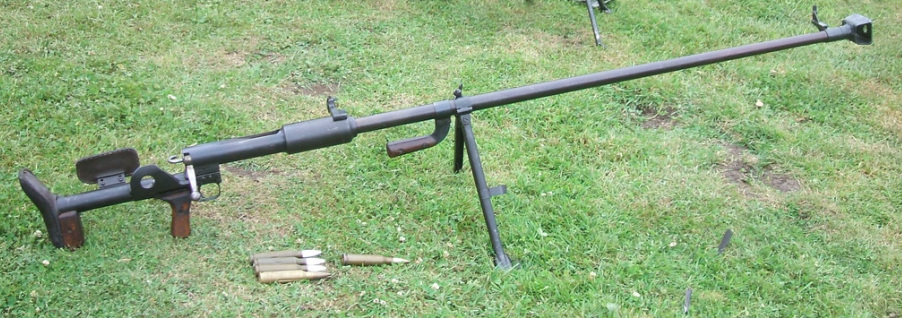
PTRD with 14.5 ammunition. The loading breach is on top of the receiver. The recoil force is reduced by the muzzle brake, the butt pad and the spring in the telescopic butt-carriage. The design has an interesting feature that increases the rate of fire of the gun and reduces the fatigue of the gunner. When recoiling rearwards, the bolt handle engages with a cammed metal bracket fixed to the right side of the stock carriage(shown just above the pistol grip), which opens the spring tensioned bolt and ejects the empty cartridge case via a port in the bottom of the receiver.The No.2 would then reload via the top breach. Typically, the troops used nicknames for their weapons, the PTRD was " удочка", (Oudochka), the "Fishing Rod!"
Calibre: 14.5 x 114 mm API round. Operation: Bolt action single shot. Weight: 17.3 Kg. Length: 2,020 mm.
Velocity: 1013 mtrs p/sec. Range: Max- Up to 3000 mtrs. Effective- up to 2400 mtrs. Practical 500 mtrs.
Practical rate of fire: 8-10 rounds p/min. Crew: Gunner & Asst. Gunner.
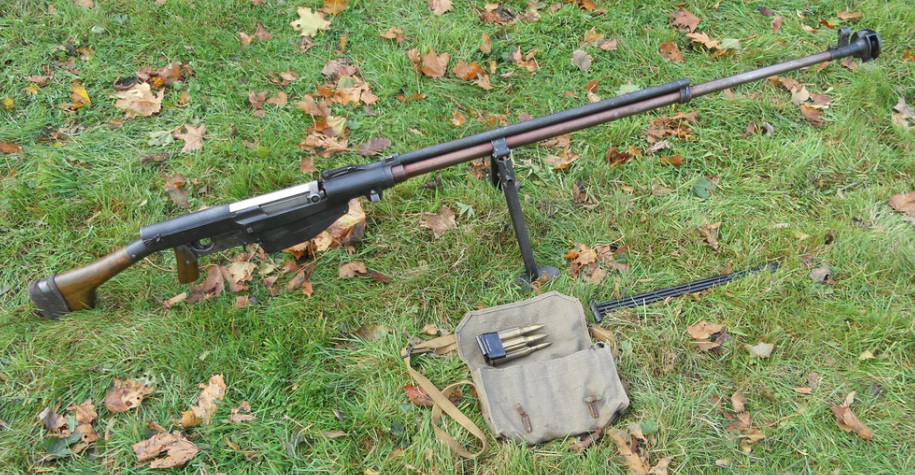 PTRS with 5 round clip, ammunition pouch and cleaning rod. The interior of the PTRS ammo pouch had individual compartments, for the 5 round clips, with a total of 20 rounds per pouch. The magazine was permanently fixed to the weapon and was hinged at its front end, to allow it to drop down to load the ammunition clip by the No.2.
PTRS with 5 round clip, ammunition pouch and cleaning rod. The interior of the PTRS ammo pouch had individual compartments, for the 5 round clips, with a total of 20 rounds per pouch. The magazine was permanently fixed to the weapon and was hinged at its front end, to allow it to drop down to load the ammunition clip by the No.2.
PTRSD 41.Protivo Tankovoye Ruzhyo Simonova Obr 1941.
Calibre: 14.5 x 114 mm API round. Operation: Gas-operated; short stroke gas piston, semi automatic vertically tilting bolt, 5-round clip internal magazine. Weight: 20.3 Kg. Length: 2100mm. Velocity: 1013 mtr p/sec. Range: Max- Up to 3000 mtrs. Effective- up to 1500 mtrs. Practical 500 mtrs. Practical rate of fire: 10-15 rounds p/min. Crew: Gunner & Asst. Gunner.
Calibre: 14.5 x 114 mm API round. Operation: Gas-operated; short stroke gas piston, semi automatic vertically tilting bolt, 5-round clip internal magazine. Weight: 20.3 Kg. Length: 2100mm. Velocity: 1013 mtr p/sec. Range: Max- Up to 3000 mtrs. Effective- up to 1500 mtrs. Practical 500 mtrs. Practical rate of fire: 10-15 rounds p/min. Crew: Gunner & Asst. Gunner.
Model 1937 45mm (53-K) Anti Tank Gun.
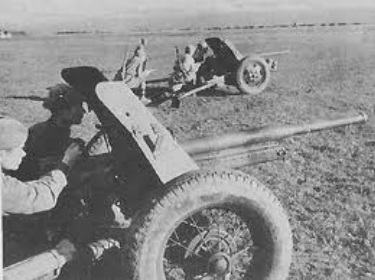
Early M37's had spoked wheels, later models had pressed steel ones.
The gun originally derived from the 37mm gun, which the Soviets purchased in 1930 from Germany and built under license as the M1930. In 1932 the Soviets produced their own variant with a calibre of 45mm. In 1937 the slightly revised M1937 appeared and the gun first saw action in the Winter War 1939-40 and was quite effective against the small numbers of lightly armoured Finnish tanks and armoured vehicles.
When the Germans invaded the Soviet Union in June 1941 the gun proved to be less effective against the German tanks. The Soviets discovered that the only way to take on the German armoured formations was to employ massed artillery tactics. Also, at the time the Soviets were unable to manufacture heavier anti tank weapons, as their facilities were being over run by the advancing Germans.
In 1942 the M1942 45mm gun appeared, which had a longer barrel that increased muzzle velocity. Although it marginally increased its effectiveness, the Soviets continued to use the M1942 in large numbers until the end of the war, which provided basic anti tank support of two M 37/42 guns to an infantry battalion.
During the war 34,345 Model 37's were produced until 1943 when they were replaced by the new more powerful Model 42 gun.
When the Germans invaded the Soviet Union in June 1941 the gun proved to be less effective against the German tanks. The Soviets discovered that the only way to take on the German armoured formations was to employ massed artillery tactics. Also, at the time the Soviets were unable to manufacture heavier anti tank weapons, as their facilities were being over run by the advancing Germans.
In 1942 the M1942 45mm gun appeared, which had a longer barrel that increased muzzle velocity. Although it marginally increased its effectiveness, the Soviets continued to use the M1942 in large numbers until the end of the war, which provided basic anti tank support of two M 37/42 guns to an infantry battalion.
During the war 34,345 Model 37's were produced until 1943 when they were replaced by the new more powerful Model 42 gun.
45 mm Anti Tank Gun.
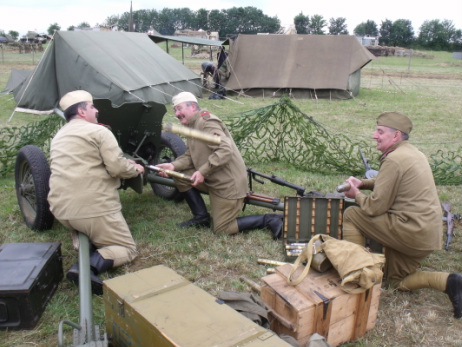
45mm gun crew training.
Factory designation: 53-K.
Weight: Gun 560 kgs. Gun, limber and all equipment 1200 kgs.
Calibre: 45mm. Shell: 45 x 310 mm R.
Elevation: - 8 to + 25 degrees. Traverse 60 degrees.
Muzzle velocity: 760 mtrs p/sec. Max range: 4.4 kms.
Ammunition types: Armour Piercing, High Explosive Fragmentation, Cannister, Smoke, AP Chemical and Training.
Crew:(Nov 1942 TO&E) Section Chief NCO, Chief Gunner NCO, 5 x Assistant Gunners and 1x Driver.
Each section had one gun and one horse drawn limber.
The units example was imported to the UK from Finland and it is assumed it was captured from the Soviets by the Finns during the Winter War 1939-40.
Grenades.
Below is a selection of anti personnel and anti tank grenades which we use on our displays
F-1 Anti personnel fragmentation defensive grenade.
Fougaznaya -1 grenata.
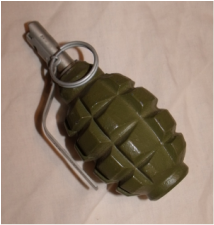
F1 grenade.
The grenade had been in Soviet service since 1939 and was based on the French F1 grenade of 1915, which originally used a lighter-based detonation, and later the pattern 1916 and 1917 Billant fuses ,which gave the grenade a time fuse capability and was adopted by many nations including the Soviet Union and the US.
It was used with the Soviet URZGM fuze, which was also in use with other types of Soviet grenades. Fuze delay could vary, standard was 3.5 - 4.2 seconds and from instantaneous and to 13 seconds for use in booby traps. It had a steel ribbed exterior which fragmented on detonation. It could be thrown about 30-45 metres and had a shrapnel blast radius of up to 200 metres and an effective radius of about 30 metres.
The troops referred to the grenade as the 'limonka', i.e. lemon because of it's shape.
Weight: 600 grams. Length: 130 mm. Diameter: 55 mm. Explosive: 0.60 kg TNT.
It was used with the Soviet URZGM fuze, which was also in use with other types of Soviet grenades. Fuze delay could vary, standard was 3.5 - 4.2 seconds and from instantaneous and to 13 seconds for use in booby traps. It had a steel ribbed exterior which fragmented on detonation. It could be thrown about 30-45 metres and had a shrapnel blast radius of up to 200 metres and an effective radius of about 30 metres.
The troops referred to the grenade as the 'limonka', i.e. lemon because of it's shape.
Weight: 600 grams. Length: 130 mm. Diameter: 55 mm. Explosive: 0.60 kg TNT.
RGD-33 Anti personnel fragmentation grenade.
Ruzhyo Grenata Dyakonova 1933.
Ruzhyo Grenata Dyakonova 1933.
Designed by M.G Dyakonov (who also designed a grenade launcher system for the Mosin Nagant rifle) and came into service in 1933 to replace the Model 1914/30 stick grenade. It could be used both as an offensive grenade and with the addition of a fragmentation sleeve into a defensive grenade. It had a fuze delay of 4 -5 seconds. It could be thrown about 30 -40 metres, with a blast radius of 15 metres with the fragmentation sleeve and 10 metres without.
Weight: 500 grams, 750 grams with fragmentation sleeve. Length: 190 mm. Diameter: 45 mm, 54 mm with fragmentation sleeve. Explosive: 0.85 kg TNT.
Designed by M.G Dyakonov (who also designed a grenade launcher system for the Mosin Nagant rifle) and came into service in 1933 to replace the Model 1914/30 stick grenade. It could be used both as an offensive grenade and with the addition of a fragmentation sleeve into a defensive grenade. It had a fuze delay of 4 -5 seconds. It could be thrown about 30 -40 metres, with a blast radius of 15 metres with the fragmentation sleeve and 10 metres without.
Weight: 500 grams, 750 grams with fragmentation sleeve. Length: 190 mm. Diameter: 45 mm, 54 mm with fragmentation sleeve. Explosive: 0.85 kg TNT.
RG-41.
Ruzhyo Grenata -1941.
RG-41 - The RG-41 was designed by N.P. Belyakova and introduced in service in 1941. It was an anti-personnel fragmentation grenade intended for use as an offensive grenade, in that the throwing range is farther than the spread of fragments i.e. lethal up to 5 metres with a spread of fragments up to 20 metres. It could be thrown between 30-40 metres. In order to arm it, the top of the grenade was hinged and the 'pencil' detonator fuse could be inserted into the detonator tube. The fuse had a delay of 3.2-3.8 seconds.
It was in service for one year only and it was used actively during the early days of the war, but by mid 1942 it had disappeared from circulation. This was due to the introduction of the RG-42 grenade, which was more effective as it could be used both as an offensive and as a defensive grenade, due to the addition of a removable fragmentation sleeve. Also, with the introduction of the UZRG type fuse,common to both the RG-42 and F-1 grenades, it obviated the need to manufacture different types of fuses for the various anti-personnel grenades..
Weight: 0.44 kg. Length: 105 mm. Diameter: 53 mm. Explosive: 150 grams TNT or Amatol. Throw range 30-40 meters
It was in service for one year only and it was used actively during the early days of the war, but by mid 1942 it had disappeared from circulation. This was due to the introduction of the RG-42 grenade, which was more effective as it could be used both as an offensive and as a defensive grenade, due to the addition of a removable fragmentation sleeve. Also, with the introduction of the UZRG type fuse,common to both the RG-42 and F-1 grenades, it obviated the need to manufacture different types of fuses for the various anti-personnel grenades..
Weight: 0.44 kg. Length: 105 mm. Diameter: 53 mm. Explosive: 150 grams TNT or Amatol. Throw range 30-40 meters
RG-42 Anti personnel fragmentation grenade.
Ruzhyo Grenata -1942.
In 1941 as an economy replacement for the complex RGD 33 grenade, the RG-41 fragmentation grenade was developed. It was only in production for a short time 1941-42, when it was replaced by the S.G. Korshunov designed RG-42 grenade. It was a simple metal can with explosive content inside and It used the standard URZGM fuze with a delay of 3.2- 4.2 seconds. It could be thrown 35-40 metres and with fitted with a fragmentation sleeve it had a blast radius of 10 metres. The grenade remained in service with the Soviet Union and its Warsaw Pact allies until 1954, when it was replaced by the RGD-5 grenade.
Weight: 420 grams. Length: depending on type of fuze 121-130 mm. Diameter: 55 mm. Explosive: 110-120 grams TNT.
Weight: 420 grams. Length: depending on type of fuze 121-130 mm. Diameter: 55 mm. Explosive: 110-120 grams TNT.
RPG-40 Anti Tank Grenade.
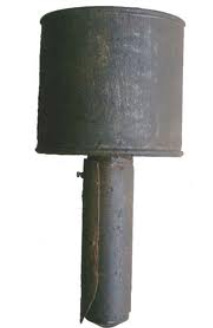
Ruzhyo Protivotankovy Grenata Obr 1940.
This blast effect anti tank grenade was introduced into service in 1940. It was detonated by contact and the blast effect was capable of penetrating 20 mm of armour. On thicker armour it would cause spalling, i.e. the breaking off of flakes of metal on the interior of the tank, which caused injury to the tank crew.
It was effective against the earlier German tanks, but less so against later models such as the Panzer 4 and 5 models.
It was replaced by the RPG-43 anti tank grenade.
Weight: 1.22 kg. Length: 20 cm. Explosive: 0.612 kg TNT.
This blast effect anti tank grenade was introduced into service in 1940. It was detonated by contact and the blast effect was capable of penetrating 20 mm of armour. On thicker armour it would cause spalling, i.e. the breaking off of flakes of metal on the interior of the tank, which caused injury to the tank crew.
It was effective against the earlier German tanks, but less so against later models such as the Panzer 4 and 5 models.
It was replaced by the RPG-43 anti tank grenade.
Weight: 1.22 kg. Length: 20 cm. Explosive: 0.612 kg TNT.
RPG-43 Anti Tank Grenade.
Ruzhyo Protivotankovoye Grenata Obr 1943.
The RPG-43 was introduced in April 1943 replacing the earlier RPG-40 and RPG-41 grenades, which were adequate against the earlier German tanks, but with the introduction of the heavier Tiger and Panther they were rendered virtually useless against these new tanks!
Externally, the RPG-43 looked like a stick grenade,with an over sized 95 mm diameter warhead at its end. The High Explosive Anti Tank (HEAT) Shaped or Hollow charged warhead, i.e.designed so that the explosive charge within, is shaped to focus the effect of the explosive's energy. It was capable of penetrating armour up to 75 mm/3.0 inches and to effectively do so, the grenade warhead had to strike the armour as near as possible to an angle of 90 degrees to activate the inertial impact fuze. To order to do this, when thrown, a cylindrical metal cone was released from the rear of the grenade and held two fabric strips designed to stabilise flight and increase the likelihood of a 90 degree contact. Its range was limited as to how far the user could throw it, who had to get closer to the target. However, it was smaller than the rocket propelled grenade launchers at the time and did not produce any flash,smoke or sound discharge, unlike the Panzerfaust and US Bazooka, and therefore not likely to betray a thrower's position. Despite its limitations, it was cheap and easy to manufacture and became one of the main Soviet infantry anti-tank weapons of the war.
Following the Battle of Kursk the RPG-6 Anti Tank Grenade underwent testing and went into service in October 1943 as a replacement for the RPG-43. However, the RPG-43 remained in service alongside the RPG-6 during the remainder of the war.
Weight: 1.247 kg. Length: 300 mm. Diameter: 95 mm. Explosive: 0.612 kg TNT.
Externally, the RPG-43 looked like a stick grenade,with an over sized 95 mm diameter warhead at its end. The High Explosive Anti Tank (HEAT) Shaped or Hollow charged warhead, i.e.designed so that the explosive charge within, is shaped to focus the effect of the explosive's energy. It was capable of penetrating armour up to 75 mm/3.0 inches and to effectively do so, the grenade warhead had to strike the armour as near as possible to an angle of 90 degrees to activate the inertial impact fuze. To order to do this, when thrown, a cylindrical metal cone was released from the rear of the grenade and held two fabric strips designed to stabilise flight and increase the likelihood of a 90 degree contact. Its range was limited as to how far the user could throw it, who had to get closer to the target. However, it was smaller than the rocket propelled grenade launchers at the time and did not produce any flash,smoke or sound discharge, unlike the Panzerfaust and US Bazooka, and therefore not likely to betray a thrower's position. Despite its limitations, it was cheap and easy to manufacture and became one of the main Soviet infantry anti-tank weapons of the war.
Following the Battle of Kursk the RPG-6 Anti Tank Grenade underwent testing and went into service in October 1943 as a replacement for the RPG-43. However, the RPG-43 remained in service alongside the RPG-6 during the remainder of the war.
Weight: 1.247 kg. Length: 300 mm. Diameter: 95 mm. Explosive: 0.612 kg TNT.
RPG-6 Anti Tank Grenade.
Ruzhyo Protivotankovoye Grenata - 6.
The RPG-6 grenade also had a High Explosive Anti Tank (HEAT) Shaped or Hollow charged warhead and was a further development on the RPG-43 to increase explosive effectiveness. The issue with the RPG-43 was if it did not strike the target as close to an angle of 90 degrees,the activation of the inertial impact fuze was likely not to occur and the grenade often bounced off without being detonated! Development found that optimal performance was gained from a (HEAT) warhead if it exploded a short distance from the armour, calculated as similar to the same distance as the weapon's warhead diameter. This was achieved by adding a hollow domed nose section with an impact fuse in it, so that when the weapon detonated, the warhead was at the optimum distance from the armour to achieve maximum explosive effect.The RPG-6 was capable of penetrating up to 100 mm of armour and had fragmentation radius of 20 meters and proved useful against infantry also. In flight,the RPG-6 also deployed fabric strips to stabilise, four in total.It came into service in October 1943 and was produced alongside the RPG-43.
Weight: 1.13 kg. Length: 337 mm. Diameter:103 mm.Explosive: 0.562 kg.
Weight: 1.13 kg. Length: 337 mm. Diameter:103 mm.Explosive: 0.562 kg.
